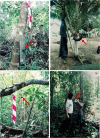Diversity of mosquitoes (Diptera: Culicidae) collected in different types of larvitraps in an Amazon rural settlement
- PMID: 33006968
- PMCID: PMC7531793
- DOI: 10.1371/journal.pone.0235726
Diversity of mosquitoes (Diptera: Culicidae) collected in different types of larvitraps in an Amazon rural settlement
Abstract
Anthropogenic environments provide favorable conditions for some species, which is especially true of mosquitoes that present eclecticism at the moment of choice for the site of oviposition. In the present study, the diversity of mosquitoes was assessed by providing plastic containers, bamboo internodes, and tires in a forest, the forest edge, and peridomicile environments in a rural settlement area. Eighteen sampling points were chosen, delimited by a buffer of 200 m, placed in three environments: forest, forest edge, and peridomicile. In each environment, larvitraps were installed, separated by a minimum distance of 7 m and 1 m from the ground. A total of 10,131 immature mosquitoes of 20 species were collected. The most abundant species was Culex urichii (29.5%), followed by Trichoprosopon digitatum (27.1%), and Cx. (Melanoconion) spp. (10.4%). There was a difference in the composition of immature mosquito populations between larvitraps (p < 0.0005), and the plastic container hosted a greater diversity of species, whereas tires presented a greater abundance of individuals. The forest, forest edge, and peridomicile environments were also different with regard to diversity of immature mosquito populations (p < 0.0010). The forest edge was the environment with the greatest diversity of species, followed by the peridomicile and forest environments. In the forest and peridomicile, plastic container larvitraps had the greatest diversity, whereas the forest edge tire presented the largest number of individuals. Further, tire larvitraps collected the largest number of individuals in all environments. Ten species associated with the bamboo internode and tire were identified. The preference of species for artificial larvitraps, such as the plastic container and tire, even in wild environments was noted. These artificial objects may represent a risk factor for the population living in this region, as all vector species found in the study were present in plastic containers and tires.
Conflict of interest statement
The authors have declared that no competing interests exist.
Figures




Similar articles
-
Change in the faunal composition of mosquitoes (Diptera: Culicidae) along a heterogeneous landscape gradient in the Brazilian Amazon.PLoS One. 2023 Jul 13;18(7):e0288646. doi: 10.1371/journal.pone.0288646. eCollection 2023. PLoS One. 2023. PMID: 37440515 Free PMC article.
-
Diversity and relative abundance of immature mosquitoes (Diptera: Culicidae) in Hohenbergia catingae Ule bromeliads and larvitraps in the Nísia Floresta National Forest, northeast Brazil.J Med Entomol. 2024 Sep 10;61(5):1232-1239. doi: 10.1093/jme/tjae085. J Med Entomol. 2024. PMID: 38991848
-
Distribution and diversity of mosquitoes and Oropouche-like virus infection rates in an Amazonian rural settlement.PLoS One. 2021 Feb 16;16(2):e0246932. doi: 10.1371/journal.pone.0246932. eCollection 2021. PLoS One. 2021. PMID: 33592052 Free PMC article.
-
[Mosquito (Diptera: Culicidae) ecology in natural and artificial rural breeding places in northern Parana, Brazil. V. Larvae collection in artificial containers installed in ciliary forest].Rev Saude Publica. 1997 Aug;31(4):370-7. doi: 10.1590/s0034-89101997000400006. Rev Saude Publica. 1997. PMID: 9595766 Portuguese.
-
Tires as habitats for mosquitoes: a review of studies within the eastern United States.J Med Entomol. 2008 Jul;45(4):581-93. doi: 10.1603/0022-2585(2008)45[581:tahfma]2.0.co;2. J Med Entomol. 2008. PMID: 18714856 Review.
Cited by
-
Mosquito (Diptera: Culicidae) Diversity and Community Structure in Doi Inthanon National Park, Northern Thailand.Insects. 2022 Sep 7;13(9):814. doi: 10.3390/insects13090814. Insects. 2022. PMID: 36135515 Free PMC article.
-
Relative effects of urbanisation, deforestation, and agricultural development on mosquito communities.Landsc Ecol. 2023;38(6):1527-1536. doi: 10.1007/s10980-023-01634-w. Epub 2023 Mar 20. Landsc Ecol. 2023. PMID: 37229481 Free PMC article.
-
Forest edge landscape context affects mosquito community composition and risk of pathogen emergence.iScience. 2024 Dec 12;28(1):111576. doi: 10.1016/j.isci.2024.111576. eCollection 2025 Jan 17. iScience. 2024. PMID: 39868037 Free PMC article.
-
Microclimate and the vertical stratification of potential bridge vectors of mosquito‑borne viruses captured by nets and ovitraps in a central Amazonian forest bordering Manaus, Brazil.Sci Rep. 2021 Oct 26;11(1):21129. doi: 10.1038/s41598-021-00514-0. Sci Rep. 2021. PMID: 34702887 Free PMC article.
-
Change in the faunal composition of mosquitoes (Diptera: Culicidae) along a heterogeneous landscape gradient in the Brazilian Amazon.PLoS One. 2023 Jul 13;18(7):e0288646. doi: 10.1371/journal.pone.0288646. eCollection 2023. PLoS One. 2023. PMID: 37440515 Free PMC article.
References
-
- Grimaldi D, Engel MS, Engel MS. Evolution of the Insects Cambridge University Press; 2005.
-
- Amorim D de S. Neotropical Diptera diversity: richness, patterns, and perspectives. Diptera diversity: Status, challenges and tools. Brill; 2009. p. 460.
-
- Silva FS, Carvalho LPC. A population study of the Culicoides biting midges (Diptera: Ceratopogonidae) in urban, rural, and forested sites in a cerrado area of Northeastern Brazil. Ann Entomol Soc Am. 2013;106: 463–470. 10.1603/AN12047 - DOI
Publication types
MeSH terms
LinkOut - more resources
Full Text Sources
Medical
Miscellaneous

